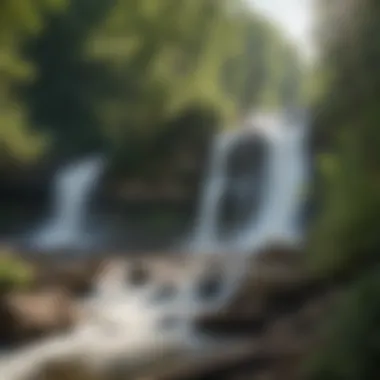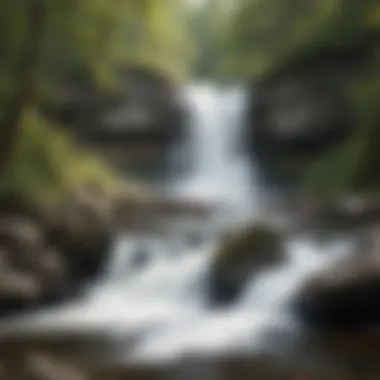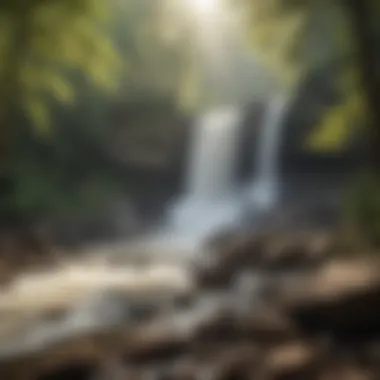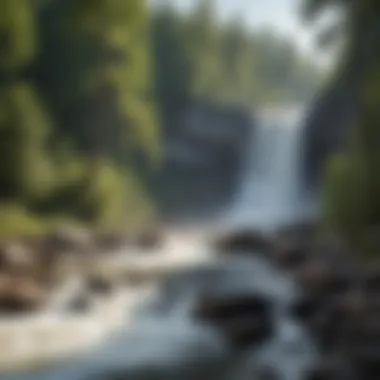Unveiling the Spectacular Beauty of White Water Falls in North Carolina


Evergreen Trees Species
White Water Falls in North Carolina is not only renowned for its majestic cascades, but also for the lush evergreen trees that populate its surrounding forests. These evergreen trees contribute to the area's ecological significance by providing habitat and sustenance for various wildlife species. The forest management techniques employed in these areas prioritize the preservation of these trees through sustainable logging practices and wildlife habitat preservation strategies.
Types of Evergreen Trees
The forests around White Water Falls house a diverse array of evergreen tree species, including Eastern White Pine, Fraser Fir, and Red Cedar. These trees not only add to the scenic beauty of the landscape but also play a crucial role in maintaining the ecological balance of the region. Understanding the different types of evergreen trees enriches the exploration of White Water Falls and its environs.
Ecological Significance
Evergreen trees hold immense ecological importance in American forests. Their year-round foliage provides shelter for wildlife, helps prevent erosion, and contributes to the overall health of forest ecosystems. Exploring the ecological significance of evergreen trees sheds light on their vital role in preserving biodiversity and sustaining healthy forest environments.
Conservation Practices
To safeguard the evergreen trees in the vicinity of White Water Falls, conservation practices are essential. Conservation efforts focus on implementing strategies to protect and preserve these trees, ensuring the long-term sustainability of the forest ecosystem. Highlighting conservation practices underscores the commitment to maintaining the natural beauty and ecological richness of the area.
Outdoor Activities in Evergreen Forests
In addition to marveling at the grandeur of White Water Falls, visitors have the opportunity to engage in various outdoor activities within the lush evergreen forests that encompass the area. From serene hiking trails to prime birdwatching spots, the forests offer a plethora of recreational opportunities for nature enthusiasts and adventurers alike.
Hiking Trails Exploration
Traversing the hiking trails winding through the evergreen forests presents a unique opportunity to immerse oneself in nature's tranquility. The diverse flora and fauna along these trails provide an enriching hiking experience, allowing visitors to connect with the natural beauty and serenity of the forested landscape.
Camping Destinations
For those seeking a more immersive experience, camping in the heart of American evergreen forests offers unparalleled access to the wilderness. Discovering top camping spots in the region provides camping enthusiasts with a chance to witness the forest's nocturnal beauty and awaken to the sounds of wildlife in their natural habitat.
Nature Photography Opportunities
Photography enthusiasts can capture the essence of the evergreen forests through their lens, documenting the captivating beauty of the landscape at different times of the day. Nature photography opportunities abound in the area, showcasing the harmony between light, shadows, and the verdant hues of the forest canopy.
Birdwatching Enthusiasts
The evergreen trees in the vicinity of White Water Falls attract a diverse array of bird species, making it a haven for birdwatching enthusiasts. Observing these avian inhabitants in their natural habitat provides a unique insight into the importance of evergreen forests as rich ecosystems that support a variety of wildlife.
Management and Preservation of Evergreen Forests
Preserving the integrity of American evergreen forests involves implementing effective management practices to ensure their longevity and vitality. From historical context to conservation efforts showcase, a holistic approach to managing and preserving these forests is essential for safeguarding their ecological diversity and cultural significance.
Historical Context
Exploring the historical context of American evergreen forests unveils the deep-rooted connections between nature and indigenous practices. Understanding the historical significance of these forests allows us to appreciate their resilience and importance in shaping the cultural and environmental heritage of the region.
Research Findings
Recent research studies have shed light on the biodiversity and sustainable management practices within American evergreen forests. Synthesizing these research findings offers valuable insights into enhancing conservation efforts and strengthening the ecological sustainability of these vital ecosystems.
Conservation Efforts Showcase
Highlighting ongoing conservation initiatives aimed at protecting American evergreen landscapes showcases the collaborative efforts of individuals and organizations dedicated to preserving the natural beauty of these forests. Success stories in conservation serve as inspiration for further endeavors in ensuring the long-term health and vibrancy of evergreen forests.


Introduction to White Water Falls
White Water Falls in North Carolina stands as a captivating natural wonder, drawing in visitors with its majestic cascades and unspoiled surroundings. This section serves as a gateway to the enchanting allure of the falls, offering insights into its geological significance, ecological diversity, and recreational opportunities.
Geological Formation
The geological formation of White Water Falls is a testament to the forces of nature at work. Erosion and sedimentary layers have sculpted the landscape, creating a spectacle of cascading waters that mesmerize all who behold them.
Erosion and Sedimentary Layers
Erosion plays a critical role in shaping the rugged terrain surrounding White Water Falls. Over centuries, the relentless force of water has carved deep gorges and channels, revealing layers of sedimentary rock that provide a glimpse into the earth's history. The distinct geological layers showcase the passage of time and the dynamic processes that have sculpted the land into its present form.
Impact of Water Flow
The impactful presence of water flow at White Water Falls cannot be overstated. The relentless rush of water over cliffs and rocky outcrops not only creates a visual spectacle but also influences the surrounding ecosystem. The consistent flow of water sustains plant life, creates habitats for diverse fauna, and maintains the ecological balance of the area.
Location and Accessibility
Nestled in North Carolina, White Water Falls is a destination that offers both natural beauty and accessibility for visitors seeking a retreat into the wilderness. Understanding the coordinates, surrounding area, and visitor facilities is essential for a memorable and smooth experience at the falls.
Coordinates and Surrounding Area
The coordinates of White Water Falls place it amidst a pristine natural landscape, surrounded by lush forests and rugged terrain. These geographic coordinates not only guide travelers to the location but also hint at the immersive experience that awaits them. The surrounding area boasts hiking trails, scenic viewpoints, and opportunities for wildlife observation, making it a haven for nature enthusiasts.
Visitors' Facilities
To enhance the visitor experience, White Water Falls offers a range of facilities designed to cater to the needs of guests. From parking areas and restrooms to informational signage and designated picnic spots, visitors' facilities ensure convenience and comfort during exploration. These amenities aim to provide a seamless journey through the natural wonders of the falls, allowing visitors to connect with nature in a safe and accessible manner.
Historical Significance
The historical significance of White Water Falls extends beyond its geological formations, delving into the narratives of Native American connections and the exploration that led to its naming. Understanding these historical contexts enriches the visitor experience, offering insights into the cultural heritage and exploration milestones associated with the falls.
Native American Connection
For Native American communities, White Water Falls holds cultural significance as a sacred site connected to ancestral stories and spiritual beliefs. The presence of the falls in indigenous lore underscores its importance beyond its natural beauty, highlighting a deeper connection to the land and its historical inhabitants.
Exploration and Naming
The exploration of White Water Falls and the process of naming it reflect the human quest for discovery and appreciation of natural wonders. Early explorers braved rugged terrains to uncover the splendor of the falls, leading to its recognition and designation. The act of naming the falls serves as a tribute to its grandeur and serves to immortalize its presence in the annals of history.
Ecological Diversity of White Water Falls
In this comprehensive article exploring the captivating wonder of White Water Falls in North Carolina, a prominent focus is placed on the Ecological Diversity of this natural marvel. The Ecological Diversity of White Water Falls plays a crucial role in understanding the intricate balance of flora and fauna within its ecosystem. This section delves deep into the unique ecological attributes that make White Water Falls a thriving habitat, emphasizing its significance in preserving biodiversity and maintaining ecological stability.
Flora and Fauna
Plant Species:
The rich tapestry of plant species surrounding White Water Falls is a defining element of its ecological diversity. Various indigenous plants, including wildflowers, ferns, and deciduous trees, contribute to the lush greenery and visual allure of the region. One notable plant species is the Rhododendron maximum, commonly known as the great laurel or rosebay rhododendron. This plant species thrives in the moist, acidic soils found near the falls, boasting large clusters of vibrant pink flowers that bloom in late spring and early summer. The Rhododendron maximum not only enhances the scenic beauty of the area but also provides essential nectar for pollinators, fostering a healthy ecosystem for wildlife.
Animal Habitats:
The diverse animal habitats supported by White Water Falls add another layer of complexity to its ecological landscape. From elusive salamanders to majestic birds of prey, the falls harbor a wide array of wildlife species that depend on its pristine environment for survival. One key feature of the animal habitats is their proximity to the water source, offering abundant food and shelter for aquatic species such as trout and aquatic insects. This vibrant ecosystem supports a delicate balance of predator-prey relationships and provides visitors with glimpses of nature's interconnectedness.


Conservation Efforts
Protected Areas:
Preserving the natural beauty and ecological integrity of White Water Falls involves the establishment of protected areas within the surrounding region. These areas serve as sanctuaries for vulnerable plant and animal species, safeguarding their habitats from human disturbances and ensuring long-term sustainability. One vital aspect of protected areas is their role in promoting environmental education and fostering appreciation for the biodiversity found near the falls. By designating specific zones for conservation, authorities aim to strike a harmonious balance between human recreation and nature preservation.
Endangered Species:
The presence of endangered species near White Water Falls highlights the importance of conservation efforts in the region. Species such as the Southern Appalachian brook trout face significant threats due to habitat degradation and climate change. Protecting these endangered species involves targeted conservation strategies, including habitat restoration and population monitoring. By actively addressing the conservation needs of these vulnerable species, stakeholders contribute to the overall resilience of the ecosystem and ensure the continued existence of valuable biodiversity.
Impact of Tourism
Balancing Conservation and Recreation:
Balancing the demands of tourism with the conservation priorities of White Water Falls is a delicate yet essential endeavor. Sustainable tourism practices play a key role in mitigating the environmental impact of visitor activities while enhancing the overall visitor experience. By enforcing visitor guidelines, such as staying on designated trails and minimizing waste generation, the delicate equilibrium between conservation and recreation can be maintained. The management of visitor flows and infrastructure development aims to protect the natural heritage of White Water Falls for future generations to appreciate.
Sustainable Tourism Practices:
Integrating sustainable tourism practices into the management of White Water Falls promotes responsible stewardship of the environment and local communities. Initiatives such as eco-friendly transportation options, renewable energy sources, and community engagement programs contribute to the long-term sustainability of tourism around the falls. By adopting a holistic approach to sustainable tourism, stakeholders ensure that the economic benefits of tourism align with the conservation goals of preserving the ecological diversity of White Water Falls.
Recreational Activities at White Water Falls
Hiking Trails
Difficulty Levels
Delving into the intricacies of hiking trails at White Water Falls, the concept of difficulty levels takes center stage in providing visitors with suitable challenges based on their expertise and physical abilities. The varying degrees of difficulty cater to both novices seeking a moderate trek and seasoned hikers looking for more strenuous paths. The advantage of having different difficulty levels lies in accommodating a diverse range of visitors, making it an inclusive choice for individuals of varying skill levels. Each difficulty level presents its own set of unique characteristics, offering a tailored experience to match the desired level of challenge.
Scenic Viewpoints
Leveraging the breathtaking scenic viewpoints along the hiking trails at White Water Falls adds depth to the overall exploration, offering picturesque vistas that evoke awe and appreciation for the natural beauty surrounding the falls. These viewpoints serve as rewarding destinations along the hiking routes, providing hikers with captivating panoramic views of the cascading waters and lush surroundings. The allure of scenic viewpoints lies in their ability to offer moments of tranquility and visual delight amidst the rugged terrain, enhancing the overall trekking experience.
Water Activities
Swimming Spots
The inclusion of swimming spots in the recreational repertoire at White Water Falls infuses a sense of aquatic adventure into visitors' itineraries, inviting them to cool off in the refreshing waters amidst the majestic backdrop of the falls. Highlighting specific swimming spots caters to individuals seeking a blend of serenity and aquatic enjoyment, making it a popular choice for relaxation and recreation. Each swimming spot holds its own charm, providing visitors with a unique opportunity to connect with nature through an immersive water experience.
Kayaking Opportunities
Exploring kayaking opportunities at White Water Falls opens up avenues for adrenaline-fueled adventures, as visitors navigate the rapids and currents with skilled precision amidst the pristine waters of the falls. The unique characteristic of kayaking lies in its ability to offer a thrilling yet safe water sport experience, attracting adventure enthusiasts eager to test their paddling prowess in a natural setting. Embracing kayaking opportunities adds a dynamic element to the array of water activities available, enriching the recreational landscape at White Water Falls.
Picnic Areas and Facilities
Designated Picnic Spots
Amidst the abundance of recreational offerings at White Water Falls, designated picnic spots provide visitors with designated areas to unwind, reconnect with nature, and savor outdoor dining experiences amidst breathtaking surroundings. These spots highlight the essence of communal relaxation, fostering a sense of camaraderie and shared enjoyment among visitors. The unique feature of designated picnic spots lies in their ability to offer a tranquil setting for social gatherings and leisurely picnicking, enhancing the overall recreational appeal of White Water Falls.
Amenities Available
Enhancing the visitor experience, amenities available at White Water Falls contribute to the convenience and comfort of guests exploring the recreational offerings. From restroom facilities to picnic tables and trash receptacles, these amenities cater to visitors' basic needs, ensuring a seamless and enjoyable outing amidst nature's grandeur. The key characteristic of available amenities lies in their ability to elevate visitors' comfort levels and provide essential services for a fulfilling recreational experience. Additionally, the presence of amenities adds a layer of accessibility and practicality to the overall recreational landscape at White Water Falls.
Safety Measures and Guidelines


In this section of the article, we delve into the critical importance of Safety Measures and Guidelines when exploring the mesmerizing beauty of White Water Falls in North Carolina. Safety is paramount when venturing into nature, especially in areas like waterfalls that present inherent risks. By understanding and adhering to safety protocols, visitors can ensure a memorable and secure experience throughout their journey.
Weather and Terrain Awareness
Seasonal Considerations
Seasonal considerations play a vital role in determining the safety and feasibility of visiting White Water Falls. The fluctuating weather patterns in North Carolina can significantly impact the waterfall's conditions, affecting water flow levels, trail accessibility, and overall safety. Being aware of the seasonal variations and their implications equips visitors with the knowledge needed to plan their trip effectively.
Topographic Precautions
Equally important are the topographic precautions that visitors must consider when navigating the terrain around White Water Falls. The geological makeup of the area can pose challenges such as slippery rocks, steep slopes, and unstable ground, amplifying the need for cautious exploration. Understanding the topographic features ensures that visitors can navigate the terrain safely and appreciate the beauty of the falls without compromising their well-being.
Visitor Etiquette
Visitor etiquette is a fundamental aspect of responsible tourism at White Water Falls. By following established protocols and guidelines, visitors can minimize their impact on the environment and wildlife, preserving the natural beauty of the area for future generations to enjoy. Respecting the wilderness and following appropriate etiquette enhances the overall visitor experience while protecting the delicate ecosystem surrounding the falls.
Leave No Trace Principles
Implementing Leave No Trace principles is a cornerstone of sustainable travel to White Water Falls. By minimizing waste, avoiding damage to vegetation, and respecting wildlife habitats, visitors can uphold their commitment to environmental conservation. These principles not only protect the natural landscape but also promote a culture of responsible outdoor recreation among all who visit the falls.
Respecting Wildlife
Respecting wildlife is essential for maintaining the ecological balance around White Water Falls. Visitors must exercise caution and respect when encountering native species, refraining from disruptive behaviors that can disturb the animals' natural routines. By appreciating and observing wildlife from a safe distance, visitors contribute to the harmony of the ecosystem and safeguard the well-being of the local fauna.
Emergency Protocols
In the event of unforeseen circumstances, understanding emergency protocols is a vital aspect of visitor safety at White Water Falls. Being prepared for emergencies, knowing how to communicate distress, and accessing necessary resources are crucial elements that ensure a swift and effective response in times of need.
Contact Information
Having access to relevant contact information is indispensable for addressing emergencies promptly and efficiently. Visitors should familiarize themselves with emergency contact numbers, park authorities, and nearby facilities to seek assistance in case of any unfortunate incidents. Timely communication can make a significant difference in ensuring the safety and well-being of all individuals exploring the area.
First Aid Resources
First aid resources serve as a crucial resource for addressing minor injuries and health concerns while exploring White Water Falls. Carrying a basic first aid kit and being trained in essential first aid procedures can mitigate risks and provide immediate care if accidents occur. By prioritizing safety and preparedness, visitors can navigate the unpredictable terrain around the falls with confidence and peace of mind.
Conclusion
White Water Falls in North Carolina offers a mesmerizing blend of natural beauty and recreational opportunities, making it a must-visit destination for nature enthusiasts. This section serves as a pivotal point in our exploration, encapsulating the significance and essence of our journey through this magnificent locale. By reflecting on the various aspects discussed in this article, visitors gain a comprehensive understanding of the geological, ecological, and historical facets that make White Water Falls a truly remarkable site.
Appreciating Nature's Splendor
Preservation Efforts
Preservation efforts play a crucial role in safeguarding the pristine ecosystem that surrounds White Water Falls. These initiatives focus on maintaining the delicate balance between conservation and sustainable tourism, ensuring that future generations can continue to marvel at the natural wonders of this area. The key characteristic of preservation efforts lies in their proactive approach towards mitigating human impact while promoting environmental stewardship. By embracing these efforts, visitors actively contribute to the long-term preservation of White Water Falls, thereby protecting its splendor for years to come.
Personal Reflections
Personal reflections offer a unique perspective on the profound impact that White Water Falls can have on an individual. Through personal introspection, visitors can connect on a deeper level with the ethereal beauty of this natural wonder. The key characteristic of personal reflections lies in their ability to evoke a sense of awe and appreciation for the intrinsic value of nature. By encouraging visitors to contemplate their experiences at White Water Falls, personal reflections foster a deeper connection to the environment, instilling a sense of responsibility and reverence for the wonders of the natural world.
Continued Exploration
Future Visits
Planning for future visits to White Water Falls allows individuals to experience the ever-evolving beauty of this enchanting locale. Each visit offers a renewed sense of discovery and connection with the surrounding environment, creating lasting memories that inspire a return to this captivating site. The key characteristic of future visits lies in their potential to provide new insights and experiences, shaping a continuous cycle of exploration and appreciation. By prioritizing future visits, visitors can deepen their bond with White Water Falls, fostering a profound connection that transcends mere observation.
Educational Initiatives
Educational initiatives serve as catalysts for deeper understanding and appreciation of the natural world surrounding White Water Falls. These programs aim to inform visitors about the ecological significance, historical context, and conservation efforts associated with the site, enriching their visit with knowledge and insight. The key characteristic of educational initiatives lies in their ability to bridge the gap between scientific understanding and experiential learning, fostering a holistic appreciation for the intricacies of nature. By engaging with educational initiatives, visitors not only enrich their own experiences but also contribute to the sustainability and protection of White Water Falls for future generations.



